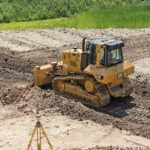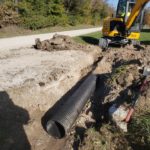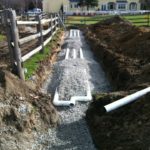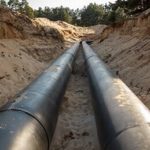We’ll make unwanted puddles a thing of the past.
Nothing is worse than watching the torrential summer rains turn your basement into a swimming pool or your yard into a lake.
If that happens to you, it means that somewhere along the line the slope (grade) of the land sent water toward your house rather than well away from it. Our grading services ensure that your land has proper water and erosion management so that your basement won’t flood, and your yard won’t turn into a lake.
Proper grading will give you some serious peace of mind, and it’s best to get it right the first time around. Call in the Earthco team for a level area to build upon and for graded land that will whisk water away from your construction.
Situations That Need Land Grading
There are two primary reasons for land grading. First and foremost is proper water drainage. Land grading allows you to use gravity to your advantage, directing all rainfall and stormwater runoff to a low-lying, out-of-the-way location, preferably one that connects to a pond or county drain. Grading for proper water drainage not only prevents floods from occurring in your home, garage or barn, but also promotes the health of any gardens, orchards or pastures. Land grading is also important on roadways and driveways in order to prevent water from collecting on them and causing vehicles to slide.
The second common reason to adjust the slope of the land is for erosion control. Erosion control means stabilizing the land to stop the topsoil—and all of the nutrients contained within—from slipping away. Specifically, land grading stabilizes the land by reducing the slope, thus reducing the runoff velocity. Slower-moving water is less powerful and less likely to strip the soil so easily.
Finally, the topography of the land can be changed to direct traffic around your property. People, and even cattle, are more likely to avoid steep inclines and undulating hills, instead seeking out gentle slopes or flat areas. Land grading can keep the more delicate areas of your property more or less free from foot traffic. This is a less common reason for land grading but is nonetheless useful.
Land grading is most commonly done when preparing a construction site. Before the major work begins, the land is cleared and the building site is leveled. In some cases, a raised building pad is also created. On all sides of the building site, the slope of the land is adjusted so that it decreases away from the construction. For buildings erected on hillsides, land grading might involve creating a berm that stops water before it reaches the building, then guides it around and away from the site.
Rough Grading Versus Final Grading
There are two stages of land grading: rough grading and final grading. Rough grading is performed first and involves moving and shifting large amounts of dirt and making drastic changes as necessary. When rough grading is done, the land should basically look as it’s meant to.
Final grading is performed second and is more precise. Final grading ensures all the contours are smooth and at the proper slope.
Sometimes there is an intermediate step, particularly if the area is meant to be a landscaped garden. When land grading is done via heavy equipment, the land can become compacted, which is not ideal for planting gardens. Therefore, topsoil may need to be brought in to backfill the area. Then, this topsoil is carefully contoured as the final grading.
Serving Macomb, Oakland, St. Clair and Lapeer Counties in Michigan.

Rough & Final Grading

Driveway & Culvert Installation

Drainage Systems
